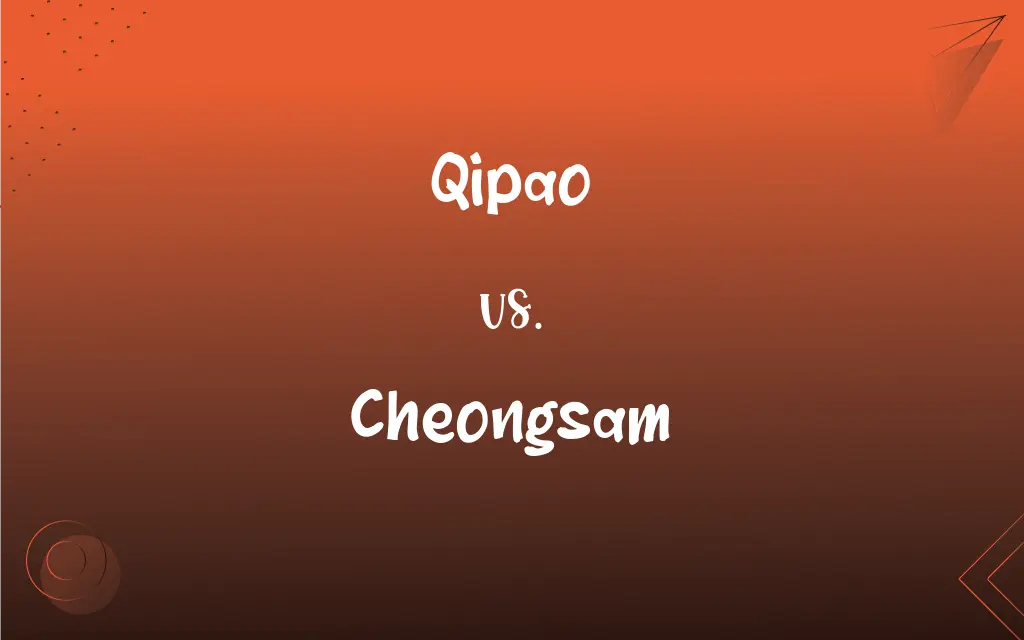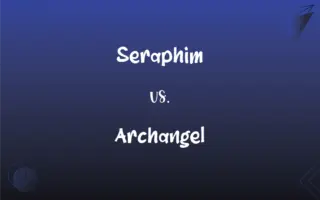Qipao vs. Cheongsam: What's the Difference?
Edited by Harlon Moss || By Janet White || Updated on October 7, 2023
Qipao and Cheongsam both refer to a traditional Chinese dress, with "Qipao" being the Mandarin term and "Cheongsam" the Cantonese term.

Key Differences
Qipao and Cheongsam are terms that often cause confusion, especially outside of Chinese-speaking communities. Historically, both words refer to the same elegant, body-hugging dress of Chinese origin. The differentiation mainly arises from linguistic variations, with Qipao being the term used in Mandarin and Cheongsam in Cantonese.
The Qipao has its origins in the Qing Dynasty and was initially a long, loose-fitting dress. As time progressed and with social and cultural changes, particularly in Shanghai during the 1920s, the dress evolved to its modern, form-fitting style. Similarly, the Cheongsam follows this historical evolution, with the name reflecting its regional linguistic preference.
To many, the distinction between Qipao and Cheongsam might seem insignificant. However, to those familiar with Chinese dialects and regional variations, these terms immediately indicate whether one is speaking Mandarin or Cantonese. Regardless of the name, both Qipao and Cheongsam represent a significant piece of Chinese cultural heritage and fashion.
In global fashion circles, one might encounter both terms. Depending on the designer's or commentator's familiarity with Chinese language and culture, they might opt for Qipao or Cheongsam. Regardless of the chosen term, the dress's unmistakable style — high collar, side slits, and intricate embroidery or patterns — remains consistent.
Both the Qipao and the Cheongsam have experienced revivals and reinterpretations, from the classic silk versions worn in the early 20th century to modern adaptations in various fabrics for different occasions. Whether one uses Qipao or Cheongsam, the dress remains a symbol of elegance and Chinese cultural pride.
ADVERTISEMENT
Comparison Chart
Linguistic Origin
Mandarin term
Cantonese term
Cultural Association
Generally same across China
Strong association with Hong Kong/Guangdong
Popularity
More widely recognized in Mainland China
More recognized in Hong Kong and overseas Chinese communities
Pronunciation
"Chee-pow"
"Chung-sam"
Meaning
Refers to the traditional Chinese dress
Refers to the same traditional Chinese dress
ADVERTISEMENT
Qipao and Cheongsam Definitions
Qipao
A symbol of Chinese femininity and elegance.
The silk Qipao accentuated her graceful demeanor.
Cheongsam
The Cantonese term for the traditional, fitted Chinese dress.
The bride chose a jade-colored Cheongsam for the tea ceremony.
Qipao
A dress evolving from Qing Dynasty origins.
The Qipao has transformed over centuries, reflecting changes in fashion and society.
Cheongsam
A dress with deep cultural and historical significance in China.
For the cultural event, many chose to wear a Cheongsam to represent Chinese heritage.
Qipao
A traditional Chinese dress, body-hugging with a high collar.
She wore a red Qipao for the Lunar New Year celebration.
Cheongsam
A garment characterized by its high neck and side slits.
The intricate embroidery on the Cheongsam caught everyone's attention.
Qipao
A representation of Chinese cultural and fashion heritage.
Wearing a Qipao is a nod to traditional Chinese aesthetics.
Cheongsam
A piece of fashion that has transcended its traditional boundaries.
Contemporary designers have given the Cheongsam a modern twist in their collections.
Qipao
A garment often adorned with intricate patterns or embroidery.
Her Qipao was beautifully detailed with golden dragon motifs.
Cheongsam
A representation of femininity and elegance in Chinese fashion.
Nothing compares to the grace of a Cheongsam at a formal event.
Qipao
See cheongsam.
Cheongsam
A formfitting dress with a high collar and usually long, slit skirt, traditionally worn by Chinese women. Also called qipao.
Qipao
A traditional one-piece dress worn by Chinese women.
Cheongsam
A tight-fitting Chinese formal woman's dress, usually brightly coloured, patterned and/or embroidered, with a split at the thigh.
Cheongsam
(Hong Kong) A plain coloured, tight-fitting dress with a short split at the thigh, worn as a school uniform by schoolgirls.
Cheongsam
A long formal dress-like garment or robe worn by Asian men.
FAQs
Does the Cheongsam have historical significance in China?
Yes, the Cheongsam, or Qipao, has evolved over centuries and holds deep cultural and historical significance.
Is the Qipao only worn on special occasions?
While traditionally worn for special events, modern adaptations of the Qipao are also worn casually.
Why might someone use the term Cheongsam over Qipao?
The choice usually reflects regional linguistic preferences, with Cheongsam being the Cantonese term.
How has the design of the Qipao changed over time?
The Qipao has evolved from a loose-fitting dress during the Qing Dynasty to the modern, body-hugging design.
What does Qipao mean?
Qipao refers to the traditional, form-fitting Chinese dress with a high collar, often known in Cantonese as Cheongsam.
Is there a difference between Qipao and Cheongsam in design?
No, both terms refer to the same style of dress. The distinction lies in the linguistic origin.
Is the Qipao worn outside of China?
Yes, the Qipao is popular internationally, often worn for cultural celebrations and fashion events.
Which term is more popular in Mainland China?
In Mainland China, Qipao, the Mandarin term, is more widely recognized.
Can men wear a version of the Qipao?
While the Qipao is female-specific, there are traditional Chinese garments for men with similar aesthetics.
How is the Cheongsam different from other traditional Chinese dresses?
The Cheongsam, or Qipao, is distinguished by its unique design elements like the high collar and side slits.
What fabrics are commonly used for the Cheongsam?
Traditionally, silk was the primary fabric, but modern versions use various materials, including cotton and synthetics.
Why is the Qipao significant in Chinese culture?
The Qipao is a symbol of Chinese femininity, elegance, and cultural heritage.
Are there modern interpretations of the Cheongsam?
Yes, contemporary designers often reimagine the Cheongsam, incorporating modern fabrics and designs.
How did the Qipao become popular in the West?
The Qipao, or Cheongsam, gained Western popularity through movies, celebrities, and global fashion events.
Is the Cheongsam considered formal wear?
While it can be formal, there are also casual versions of the Cheongsam available today.
Are Qipao and Cheongsam expensive?
The cost varies. While handcrafted silk versions can be pricey, there are affordable options in various fabrics.
Why is the Cheongsam also called a Mandarin gown?
The term "Mandarin gown" is an English descriptor, referring to the Mandarin collar, a feature of the Cheongsam.
Do both Qipao and Cheongsam have side slits?
Yes, both terms describe a dress with a high neck and characteristic side slits.
Can I wear a Qipao if I'm not Chinese?
While the Qipao holds cultural significance, many appreciate its beauty universally. It's vital to wear it respectfully and understand its history.
Do all Qipaos have intricate patterns or embroidery?
While many traditional Qipaos feature patterns or embroidery, modern versions can also be simple and unadorned.
About Author
Written by
Janet WhiteJanet White has been an esteemed writer and blogger for Difference Wiki. Holding a Master's degree in Science and Medical Journalism from the prestigious Boston University, she has consistently demonstrated her expertise and passion for her field. When she's not immersed in her work, Janet relishes her time exercising, delving into a good book, and cherishing moments with friends and family.
Edited by
Harlon MossHarlon is a seasoned quality moderator and accomplished content writer for Difference Wiki. An alumnus of the prestigious University of California, he earned his degree in Computer Science. Leveraging his academic background, Harlon brings a meticulous and informed perspective to his work, ensuring content accuracy and excellence.































































